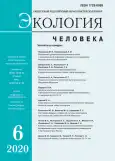PERCEPTION OF THE STATE OF EMERGENCY DUE TO COVID-19 BY MEDICAL STUDENTS AND STAFF IN A KAZAKHSTANI UNIVERSITY
- 作者: Prilutskaya M.V.1, Grjibovski A.M.2,3,4,5
-
隶属关系:
- Pavlodar branch of Semey Medical University
- Northern State Medical University
- North-Eastem Federal University
- Al Farabi Kazakh National University
- West Kazakhstan Marat Ospanov Medical University
- 期: 卷 27, 编号 6 (2020)
- 页面: 4-12
- 栏目: Articles
- URL: https://journals.rcsi.science/1728-0869/article/view/42407
- DOI: https://doi.org/10.33396/1728-0869-2020-6-4-12
- ID: 42407
如何引用文章
全文:
详细
作者简介
M. Prilutskaya
Pavlodar branch of Semey Medical University
Email: mariyapril2407@gmail.com
доктор философии (PhD), ассистент кафедры персонализированной медицины и педиатрии Pavlodar, Kazakhstan
A. Grjibovski
Northern State Medical University; North-Eastem Federal University; Al Farabi Kazakh National University; West Kazakhstan Marat Ospanov Medical UniversityArkhangelsk, Russia; Yakutsk, Russia; Almaty, Kazakhstan; Aktobe, Kazakhstan
参考
- Алтыбаева Г. К., Оспанова Н. Н., Молдагалиев Т. М., Сарсембина Ж. Ж., Сексенбаев Н. Ж., Докенова С. В. Факторы аддиктивной предрасположенности у студентов первого курса Государственного медицинского университета города Семей // Наука и Здравоохранение. 2018. № 20 (5). C. 135-144
- Гельд А. Л., Кремлева О. В. Ассоциации тревоги и депрессии при количественной оценке по HADS у пациентов с тревожной симптоматикой // Уральский медицинский журнал. 2010. № 74 (9). C. 54-60.
- Гржибовский А. М., Горбатова М. А., Маркевич А. Н., Виноградов К. А. Объем выборки для корреляционного анализа // Морская медицина. 2020. Т. 6, № 1. С. 101-106.
- Гржибовский А. М., Иванов С. В., Горбатова М. А. Корреляционный анализ данных с использованием программного обеспечения Statistica и SPSS // Наука и Здравоохранение. 2017. № 1. С. 7-36.
- Ермасов Е. В. Психологический стресс в условиях изоляции // Развитие личности. 2009. № 2. C. 84-99.
- Ишеков А. Н., Ишеков Н. С. Показатели энцефалографии у моряков и студентов в динамике арктического рейса // Морская медицина. 2017. № 3 (3). C. 55-62.
- Abraham T. Lessons from the pandemic: the need for new tools for risk and outbreak communication // Emerging Health Threats Journal. 2011. N 1 (4). P 7160.
- Andrews B., Hejdenberg J., Wilding J. Student anxiety and depression: Comparison of questionnaire and interview assessments // Journal of Affective Disorders. 2006. N 1-3 (95). P 29-34.
- Brooks S. K., WebsterR. K., Smith L. E., Woodland L., Wessely S., Greenberg N., Rubin G. J. The psychological impact of quarantine and how to reduce it: rapid review of the evidence // The Lancet. 2020. N 395 (10227). P 912-920.
- Cao W. Fang Z., Hou G., Han M., Xu X., Dong J., Zheng J. The psychological impact of the COVID-19 epidemic on college students in China // Psychiatry Research. 2020. N 287 (1 12934). P 1 12934.
- Gao J., Zheng P., Jia Y., Chen H., Mao Y., Chen S., Wang Y., Fu H., Dai J. Mental health problems and social media exposure during COVID-19 outbreak // PloS one. 2020. N 4 (15). P e0231924.
- Horesh D., Brown A. D. Traumatic stress in the age of COVID-19: A call to close critical gaps and adapt to new realities // Psychological trauma: theory, research, practice and policy. 2020. N 4 (12). P 331-335.
- Jakovljevic M., Bjedov S., Jaksic N., Jakovljevic I. COVID-19 Pandemia and public and global mental health from the perspective of global health securit // Psychiatria Danubina. 2020. N 1 (32). P 6-14.
- Magaard J. L., Seeralan T., Schulz H., Brütt A. L. Factors associated with help-seeking behaviour among individuals with major depression: A systematic review // PloS one. 2017. N 5 (12). P e0176730.
- Mo Y., Deng L., Zhang L., Lang Q., Liao C., Wang N., Qin M., Huang H. Work stress among Chinese nurses to support Wuhan for fighting against the COVID-19 epidemic // Journal of nursing management. 2020. В печати. URL: https://onlinelibrary.wiley.com/doi/epdf/10.1111/jonm.13014 (дата обращения: 26.04.2020).
- Petzold M. B., Plag J., Ströhle A. Umgang mit psychischer Belastung bei Gesundheitsfachkr ften im Rahmen der Covid-19-Pandemie // Der Nervenarzt. 2020. March 27. P 1-5.
- Rose S. Medical Student Education in the Time of COVID-19 // JAMA. 2020. В печати. URL: https://jamanetwork.com/journals/jama/fullarticle/2764138 (дата обращения: 26.04.2020).
- Soled D., Goel S., Barry D., Erfani P., Joseph N., Kochis M., Uppal N., Velasquez D., Vora K., Scott K. W. Medical student mobilization during a crisis: lessons from a COVID-19 medical student response team // Academic Medicine: Journal of the Association of American Medical Colleges. 2020. В печати. URL: https://journals.lww.com/academicmedicine/Abstract/publishahead/Medical_Student_ Mobilization_During_A_Crisis_.97220.aspx (дата обращения: 26.04.2020).
- Streiner D. L., Norman G. R., Cairney J. Health Measurement Scales: A practical guide to their development and use, 4th ed. Oxford University Press New York, 2008. 431 p.
- World Health Organization. Mental health and psychosocial considerations during the COVID-19 outbreak. WHO briefing note. 2020. URL: https://www.who.int/docs/default-source/coronaviruse/mental-health-considerations.pdf (дата обращения: 26.04.2020).
- Zhai Y., Du X. Mental health care for international Chinese students affected by the COVID-19 outbreak // The Lancet Psychiatry. 2020. Vol. 7, N 4. P e22.
补充文件







